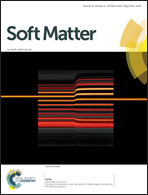Dilution induced coacervation in polyelectrolyte–micelle and polyelectrolyte–protein systems
Abstract
“Self-suppression”, the instability of complex coacervates at high concentration, is well-known for polycation–polyanion systems, but the transient nature of those complexes impedes development of a convincing model. The stable polyelectrolyte–micelle complexes of the polycation poly(diallyldimethylammonium chloride) (PDADMAC) with mixed micelles of sodium dodecyl sulfate (SDS)/Triton X-100 (TX100); and the stable complexes of PDADMAC with bovine serum albumin (BSA) can be characterized and identified as coacervate precursors. We observe liquid–liquid phase separation upon isoionic dilution, a common facet of self-suppression. While complex coacervation usually involves association of near-neutral inter-polymer complexes, dilution-induced coacervation (DIC) proceeds differently: for both systems studied, complex size decreases near the biphasic region: inter-macromolecular complexes with hydrodynamic radius Rh ∼ 100 nm dissociate to intra-polyelectrolyte complexes with Rh ≤ 30 nm. Such small complexes with ≤5 bound micelles are unlikely to be net neutral. In the polyelectrolyte–protein system, complexes are even less likely to be net neutral and the effect of dilution on size is less significant, with complex size diminishing from 50 nm to 35 nm.

- This article is part of the themed collection: Complex Coacervation


 Please wait while we load your content...
Please wait while we load your content...